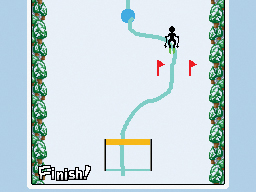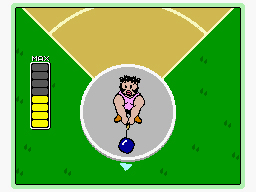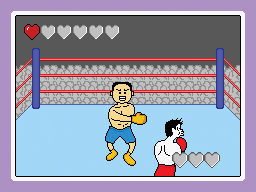|
 |
 |
 |
|
|
WarioWare: Touched!
Developer: Nintendo
Co-Developer: Intelligent Systems
Publisher: Nintendo
Number of Players: 1
Memory: 1 slot
Controls: Touch, Blow (mic)
Wi-fi Compatible: No
Release Date: 2/14/05
|
|
|
 |
 |
|
|

 |
 |
 |
Storyline
It seems that Wario's greed leads him into all sorts of types of games these days. This time, his greed for money is again the backbone of this game's storyline, for Wario wants to make money by producing another best-selling game. That game turns out to be the one for which this review is written. That seems to be the only true plot to this game. Each chapter actually has a sub-plot that doesn't quite tie in with anything else. The point of each chapter is for you to help the host character(s) in their goal by beating their set of microgames.
One would be insane to be playing this game for the story. It's not at all an important aspect to what the game is about. The plots are simple, quirky, and merely gets the job done for the type of game that WarioWare is.
|
|
 |
 |
|
|
 |
 |
 |
Gameplay
The beauty of WarioWare stems from its extreme pick-up-and-play gameplay. It's not the type of game that you'd play for consecutive hours on end, but rather one of which you play in bits and pieces. It's a short game, but the replayability is endless until, of course, you finally get bored of each and every microgame. With 190 different ones, though, it should take a while before that happens.
What makes this game so unique to every other one out there is the fact that it throws so many short microgames at you at such a quick pace. The lack of button usage and abundance of use of the touch-screen and microphone is a very welcome addition to the series. There are so many ideas thrown around within this game in the form of microgames, each of which make good use of the new technology that the Nintendo DS brings to gaming.

Players need to draw a line from the dot, through the gate(s) and to the finish line, leading the skiier to victory (click to see second screen)
Half the fun is figuring out what to do in each minigame the first time they are played. The game literally only gives players about five seconds to figure out how they're going to solve a microgame, and then solve it. It only gets quicker and harder the longer it is played without getting a Game Over, too, so that doesn't leave much time for idling.
However, the fact that the microgames are grouped together in chapters depending on what type of games they are makes it easier to figure out what to do, in turn taking away from the initial fun you could be having. For example, one chapter would be labeled as a 'rotate' chapter, which hints that what is needed to be done is rotating whatever is on screen. When that happens, players will know what type of game is coming up next and won't be on their own in figuring out what to do. The game becomes less challenging this way.

Pressing the stylus in a circular manner will have you beat this microgame. Unfortunately for the main chapters, the next mini-game will likely require a similar technique (click to see second screen)
Thankfully, there are unlockable modes in which microgames are completely randomly thrown at the player. Microgames from all the chapters are blended together, meaning that seeing the same microgame twice becomes less likely, considering the total number of microgames that are available. These randomized, mixed modes are what's best about this game. Players never know what type of game is coming up next, which essentially motivates them to be on top of their game. Missing a beat or getting the slightest bit distracted by anything outside the game could cause players to lose, and that's what makes this game so addictive. Players will want to set the highest scores for all the mini-games and chapters.
In addition to all these microgame modes are unlockable souvenirs. These small unlockables can range from a party tooter to a limited piano to a pet chameleon. There's barely any use for most of these souvenirs, but they're a neat and welcome addition nonetheless.
|
|
 |
 |
|
|
 |
 |
 |
Visuals
Technically, the best looking portion of the game are the cutscenes. Two-dimensional sprites and backgrounds reminiscent of games for the SNES and GBA systems, enhanced with a cleaner look and more colours, are exactly what make up the cutscenes. The lack of any 3D is disappointing to an extent, but it's good to see that even amidst the arrival of handhelds capable of producing nice 3D environments are games that still fully and nicely utilize 2D sprites.
Artistically, however, it's the microgames that take the cake. A large number of different styles of art is used to make the microgames. Some are as simple as having two colours on-screen, while others have very colourful and more sophisticated settings. What makes the art of the microgames so interesting is the simplicity and uniqueness that you rarely, if ever, see in games today. Considering the artists had to draw something for 190 different microgames, it is very pleasing to see that they did not go with only one style for all of them.

Exact re-creations of classic NES game scenes are present (click to see second screen)
That said, there's not really much beauty to this game. The art, while unique, isn't exactly always well-drawn. Sure, that was the artists' intentions, but it isn't going to impress anyone looking at it, as not everyone will be able to see through the charm that comes from its uniqueness. It won't matter either way, however, as everyone who plays this game should be busy focusing on each microgame's goal rather than the visuals.
|
|
 |
 |
|
|
 |
 |
 |
Sound
The sounds you hear in this game define silliness. They're designed as such, and teamed with what's happening on-screen, any person with a sense of humour should find them chuckle-worthy. Sounds of shock, laughter, encouragement, anger, and nearly every other imaginable emotion can be heard throughout the microgames and beyond. It's really quite fitting for the game, as WarioWare as a whole is the epitome of insanity.
The game even has some great tunes. Although most of the music tends to last but mere seconds in accordance to the microgames, most have some charm, or some beat that you just can't help but bop along to. The longer tunes, though small in number, have some good weight to them. An unlockable  classical remix of a Mario Paint (SNES) theme classical remix of a Mario Paint (SNES) theme left me very impressed with what is possibly the best tune in the whole game. left me very impressed with what is possibly the best tune in the whole game.
|
|
 |
 |
|
|
 |
 |
 |
In Comparison
When comparing this game to any other out there, besides its GBA and GCN predecessors, the result is that this is very unique. In fact, thanks to the touch and mic controls, there's uniqueness to be found when compared to even the previous versions of WarioWare. It's thanks to that aspect of this game that puts it above the original. There's more variety in the microgames. Instead of simply pressing a face button at the correct time as was done in the original, players need to touch, rub, spin and drag specific areas on the touch screen. It keeps the interest and freshness alive longer than the original could.
As for the GCN version of the original, which included wacky multiplayer modes, this is where disappointment lays. The DS version sports no wireless multiplayer mode, and it is sad to see. Considering the developer made a point in using the DS system's features to extremes, they appear to have forgotten about the wireless multiplayer functions.
|
|
 |
 |
|
|
 |
 |
 |
Overall
Every once in a while, a game like WarioWare comes along and takes us for a ride to which we are rarely treated. The simple, quirky, pick-up-and-play gameplay is not only addicting, it's fun. The entire game can be beaten very quickly without too much trouble, but the replayability is potentially endless. Playing the modes in which all microgames are mixed together, and aiming for a high score as the difficulty increases at a certain pace, can be addictive. The ideas behind the touch screen and microphone gameplay are innovative and don't get old.
That said, there are a few disappointments. Considering half the fun comes from figuring out what to do in each microgame the first time through, this game's grouping of them into chapters is detrimental to that very aspect of the game. This renders the experience less difficult and less surprising, thus leading to a quicker finish of the game. When you're blowing into the microphone microgame after microgame, it tends to get old quickly. Equally, knowing that the next microgame, and the one after that, will ask you to rotate something, just takes away from the aspect of surprise... An aspect intended to be very precious to this series. Luckily, the mixed microgame modes fixes that, but by then you'd already seen most of the microgames and would already know what to do in most of them. That certain dimension is missing due to the grouping, and it is disappointing in that regard.
Still, through the aforementioned problem is a shining example of a game that absolutely anyone can enjoy. Young or old, male or female, gamer or not, showing this game to the any person nearest to you will yield a common result: you'll be watching them laugh in glee while having fun rubbing and slashing the screen with the stylus.

|
|
 |
 |
|
|
 |
 |
 |
Gameplay
Simple, unique gameplay. The element of surprise is missing, which can be harmful to the fun
|
9.0
|
Visuals
Very diverse and unique styles, a refreshing change to what's on the market. It isn't going to impress people with its art, though
|
7.0
|
Sound
Hilarious sound effects and catchy tunes, even though a great number of the them are mere seconds short
|
8.5
|
Replayability
Virtually endless, getting bored of 190 microgames is unlikely to happen quickly. Present is a good number of unlockables, although a great majority of them are easy to get
|
9.5
|
|
Overall [not an average]
|
8.8
|
|
|
 |
 |
|
|
|
 |
 |
 |
 |
// A mysterious character within the Banjo-Kazooie series was meant to star in his own N64 spin-off...
Click for more . . .
|
|
 |
 |
|
|
 |
 |
 |
 |
// Delve into the philosophical world of gaming in this Pikmin 2 special, Buried Treasures
Check it out . . .
|
|
 |
 |
|
|
 |
 |
 |
[an error occurred while processing this directive]
|
 |
 |
|
|
|

























